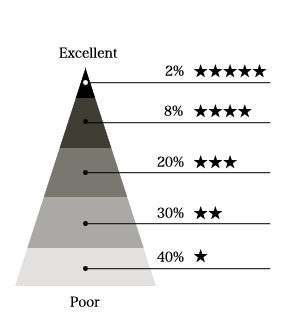When attempting to develop a new style, actual gemstones are laid out and compared to the rendered design, and their color and arrangement are evaluated. After all, drawing in paper cannot convey the actual beauty of gemstones, and often the characteristics beauty of each individual gemstone may inspire a new concept. The actual process of creating jewelry begins after decisions are made regarding how to set the stones, how the piece will feel when worn, its safety features, its total weight, the dimensions of its design, the overall balance, and its level of finish.
A talented designer’s finished work makes a lasting impression on those who see it. However, much of the jewelry that is valued for a designer’s individuality and character does not center on gemstone-oriented design, and this book does not address such jewelry. Naturally, people will clearly either like or dislike jewelry with a strong, individual character.
Countless pieces of precious metal jewelry of just gold or silver have been made since ancient times, but since precious metals are rare, they are made and melted in a continuing cycle. As a result, far fewer old pieces remain than one would expect. Nowadays, jewelry is often made in forms that follow current trends, and it is important to realize the fact that when those trends change, such jewelry is destined to be melted down. Furthermore, hen the form of a precious metal adornment is decided upon, it can be mass-produced. Gemstone-oriented jewelry is produced in limited quantities and is fundamentally different from precious metal adornments.
Among the treasures housed in the Victoria and Albert Museum in London is a collection of jewelry ranging from ancient times to the present. Here one can see that all appearances of jewelry have already been made. I believe that carefully creating jewelry by drawing from what already exists and raising its level of perfection is also an important aspect of creativity. It is often difficult to read the maker’s conceptual intent from a piece of finished jewelry. However, when holding and looking at a apiece that is based on a solid conception, the maker’s intentions can be recognized. Wonderful jewelry has a fine overall configuration, and there is much thought that goes into the fabrication process. This chain of thought is conception. |
|
THE QUALITY OF CONCEPTION
This chart shows examples of the quality of conception. Using the photographs and comments as a reference, notice how there is a difference in conception. Even with the same jewelry design, there are items ranging from high to low quality. The quality of jewelry is not in its form, but in the quality of its conception. |
 |
| Finely conceived jewelry in the range of four stars and above makes up about 10 percent of all jewelry. There are limits to the availability of the materials and workmanship that are required, but their scarcity is the very reason why the conception must be thoroughly worked out. 70 percent of all jewelry is of two-star quality or lower. They are abundant because procurement of materials is relatively easy, and they can be produced with inferior skills. |
|